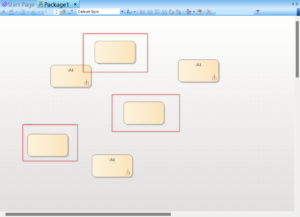Solution:
- Uninstall Enterprise Architect
- Remove the windows registry key for the particular version you have uninstalled (For the 64bit v16.1 the registry key is “HKEY_CURRENT_USER\Software\Sparx Systems\EA64”)
Everyone of us have already experienced situations that an app did not work on windows as described, as expected, or as it works on other devices or desktops. The same can happen in a Sparx Enterprise Architect (EA). I describe here my case with UML Activity Diagrams when I wanted to create a call behavior action out of an already pre-specified activity. This was the case in v16.1 but this kind of problems could happen in any version.
Normal behavior when creating a call behavior action out of activity
You can create a call behavior action in an activity diagram by drag & drop an activity from project browser on the activity diagram and dragging it as an invocation action.
1/ Select an activity you would like to drop on an activity diagram in the EA project browser.
2/ Drag&Drop the selected activity on an open activity diagram and select Invocation (Action) in Drop As dialog.
The dropped Activity will be used as a call behavior specification for a newly created Action. You can see that it is a call behavior action by a rake-style symbol in the right bottom corner of an activity element. Alternatively, you can find this information in the Kind property of the Action element.
This normally happens automatically, and it can also be seen under properties by appearance of other tabs (such as Behavior and Arguments).
When call behavior is not instantiated
In my case however, I did not get the call behavior instantiated. Instead, a Simple Action was created without a name (the highlighted Actions at the figure below).
The Actions are without rake-style symbol and in the properties, they have no Action Kind selected and they do not have the Behavior and Arguments tabs.
Once, the Call Behavior kind is selected, the classifier (in this case the A1) properly appears (See the other actions on the figure above).
Solution
The solution was at the end simple. I needed to uninstall the Enterprise Architect, to remove the registry key for the version of the uninstalled Enterprise Architect version (min my case it was v16.1, so the registry key I removed was “HKEY_CURRENT_USER\Software\Sparx Systems\EA64”) and to install the Enterprise Architect again.
Please note, it was not sufficient to uninstall and install the Enterprise Architect again. Neither was it sufficient to repair installation (selecting repair in the windows installation for enterprise architect). I had to also remove the registry key.
It seems that sometimes some installations or windows adds some data under the mentioned registry key (could be because of installed plugins or some interactions between windows, Enterprise Architect and other applications or plugins) which make the Enterprise Architect act unexpectedly. Fortunately, there is the above mentioned remedy. Please consider it also in other cases of unexpected behavior especially when it works normally on computers run by your colleagues.








